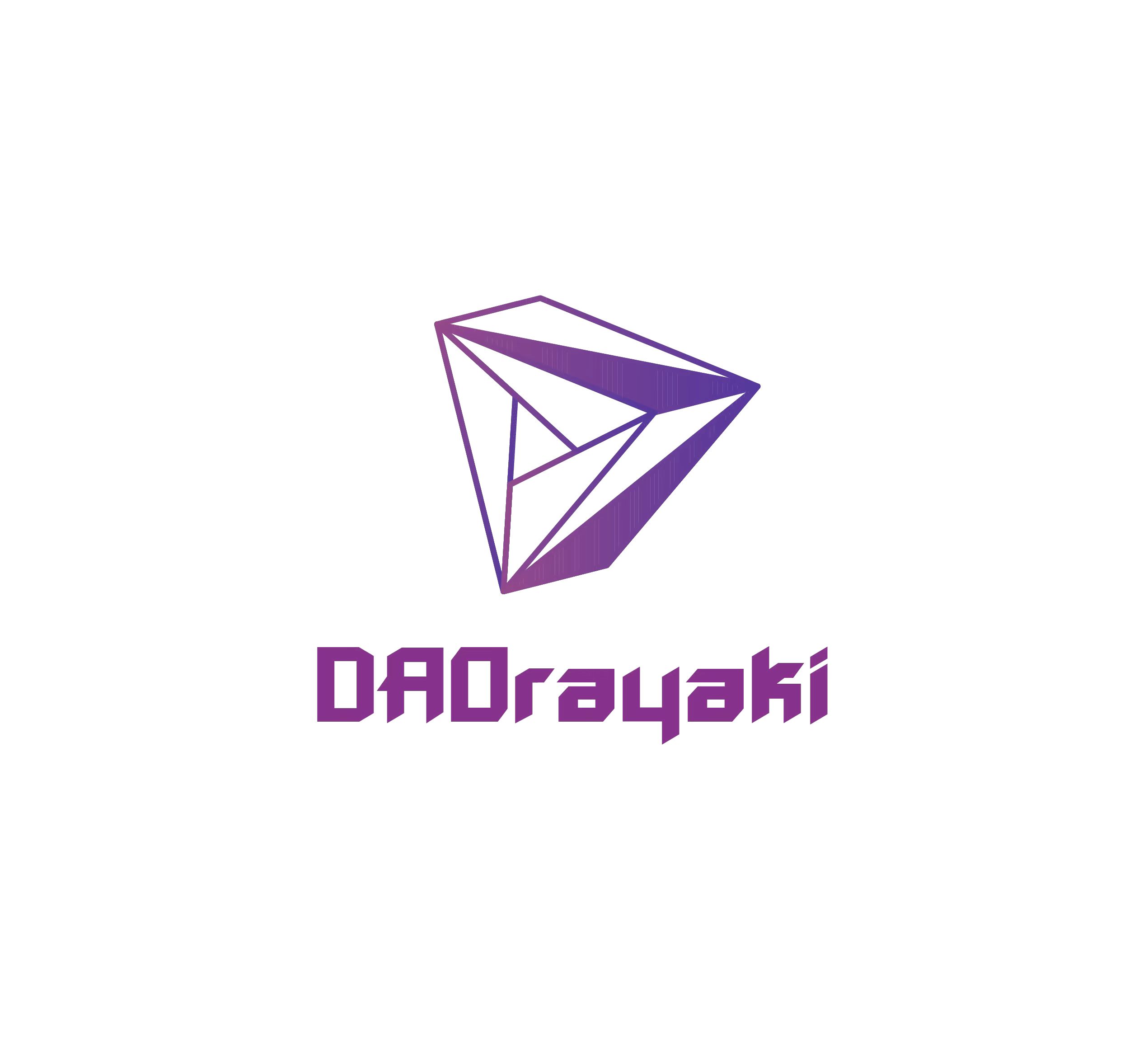thank you
thank you
Early sharing can refer to:
DAOrayaki is a fully functional decentralized media platform and research organization representing the will of the community. It aims to link creators, funders, and readers, and provide multiple governance tools such as Bounty, Grant, and prediction markets, and encourage the community to freely conduct research, curate, and report on various topics.
THUBA DAO is a decentralized organization initiated by members of the Tsinghua University Blockchain Association (THUBA). THUBA DAO is committed to bringing the Web3 world to every student, becoming a bridge connecting blockchain communities at home and abroad, and cultivating the best next-generation Web youth and pioneers.
Early sharing can refer to:
DAOrayaki THUBA DAO |Multi-case analysis of token economy design ideas
Summary
The subdivision tracks studied in this paper are: Web3 application layer - social and content scenarios - DID/innovation scenarios (represented by Metaverse 3D space).
first level title
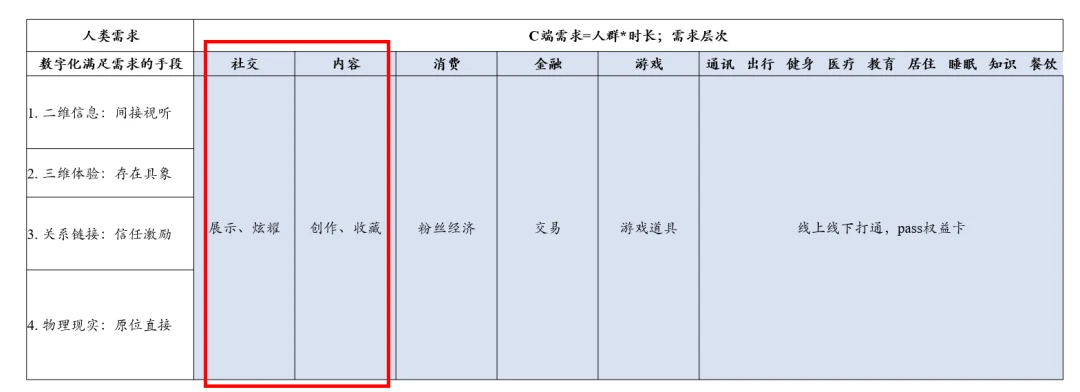
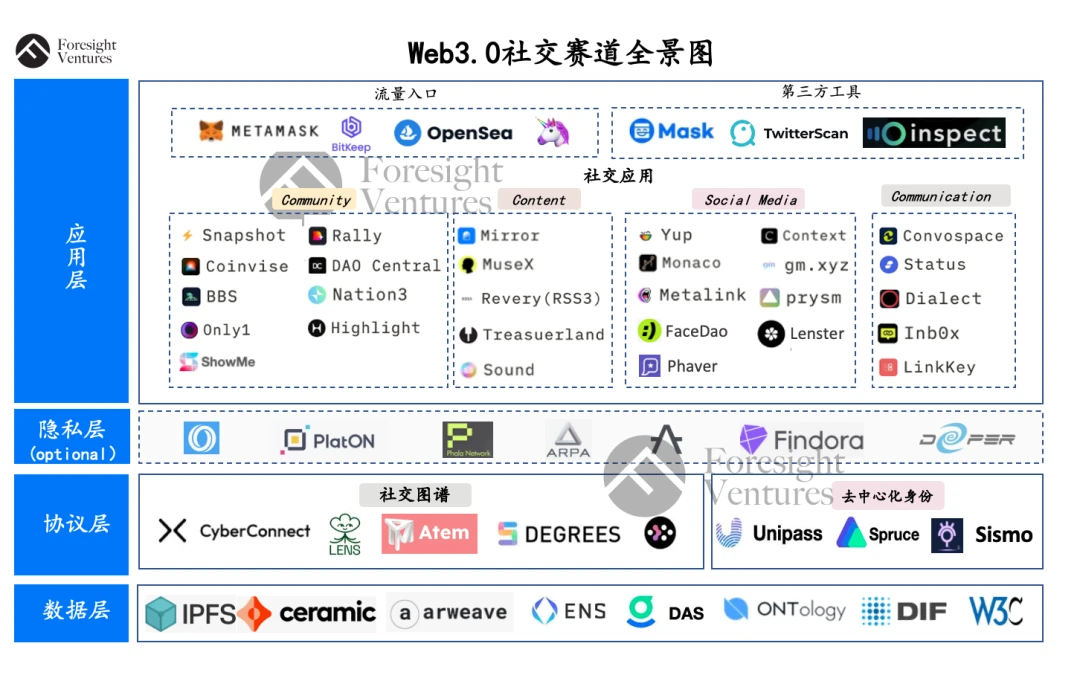
secondary title
Room for growth of the track
ⅰ. The Track Size (TAM)
There are 1.2 billion young people aged 15 to 24 in the world, and 200 million in China are initial users. Because they are willing to accept new things, are interested in new data labels, and have a lot of time, young people have a sense of identity and are very happy to accept a little economic stimulus.
The life time value of each user is 6,000 RMB (an NFT worth 20,000 RMB is created every year, and the transaction fee is 600 RMB, which lasts for 10 years).
So the market size will be: 7.2 trillion RMB globally, which is 1 trillion US dollars; 1.2 trillion RMB in China, which is 200 billion US dollars.
ⅱ. Penetration rate of this track (number of users/total number of users of cryptocurrencies)
At present, the track is very early and the number of users is low. The total address of the representative DID base Galex is about 4.2 million (without deduplication); the total number of ENS domain name registrations has exceeded 2.55 million, and the number of users is 570,000; the number of CyberConnect users has exceeded 1.5 million million people. So the penetration rate is around 1%. Users still mainly use traditional Web2 social and content software.
Note: Total users of cryptocurrency: Triple A report shows that there are currently 320 million cryptocurrency holders in the world, of which the top five countries are the United States (46.02 million, accounting for 13.74% of the population), India (27.41 million, population accounting for 2.00%), Pakistan (26.45 million, accounting for 11.50% of the population), Nigeria (22.33 million, accounting for 10.34% of the population) and Vietnam (20.21 million, accounting for 20.27% of the population). China (including the mainland and Hong Kong) ranks sixth with just over 20 million users. In addition, 72% of crypto users are under the age of 34, 71% have a bachelor’s degree or higher, and the average annual income reaches $25,000.
ⅲ. The number of users and the driving force behind them, so as to judge which stage of development the industry is in
In the early seed user stage. infancy.
The next stage is the user growth stage, the main driving factors are from three aspects:
1. In terms of channels, the promotion of low-threshold wallets (non-mnemonic wallets) has lowered the threshold for users to use wallets, private keys, and assets;
2. In terms of users minds, carry out education on real asset ownership and let users know that owning their own data assets is a matter of course, which is also the narrative logic of the entire Web3;
3. The real usage scenarios are gradually improving: not only limited to currency speculation and financial speculation scenarios, but more usage scenarios should appear. We dont just focus on OpenSeas 50,000 daily active users, or Binances 200,000 daily active trading users, we still need to go back to the fundamental needs of public Internet users, and let everyone gradually become familiar with private keys and mnemonic words (low-threshold wallets can Accelerate this process), master your own digital assets through NFT. If the time they spent on Tencent, Byte and Ali can be transferred to Web3, commercial value will definitely be realized.
ⅳ. What indicators does this track focus on?
1. Mainly focus on the number of users, which is further divided into total number of users, number of monthly active users, number of daily active users, and number of new users. In the Web3 world, the main focus is on UAW (unique active wallets). It can be seen that the transaction volume of 30-day users is low. For example, GalxeID currently has about 4.2 million addresses, and last month’s monthly activity was 570,000, so the proportion of active users is about 1/9, which is not very large.
2. Next, focus on Volume transaction volume (Web3). The projects in the picture below can be divided into two categories: DID foundation (Galxe, Lens), innovative social scenarios (metaverse, Decentraland)
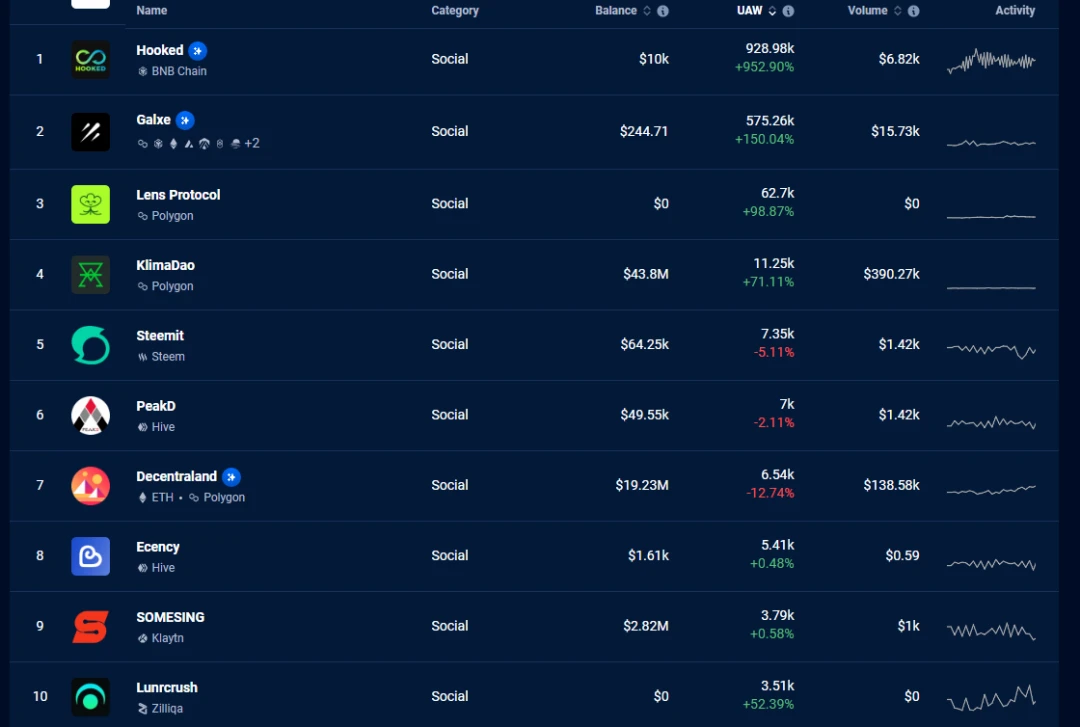
secondary title
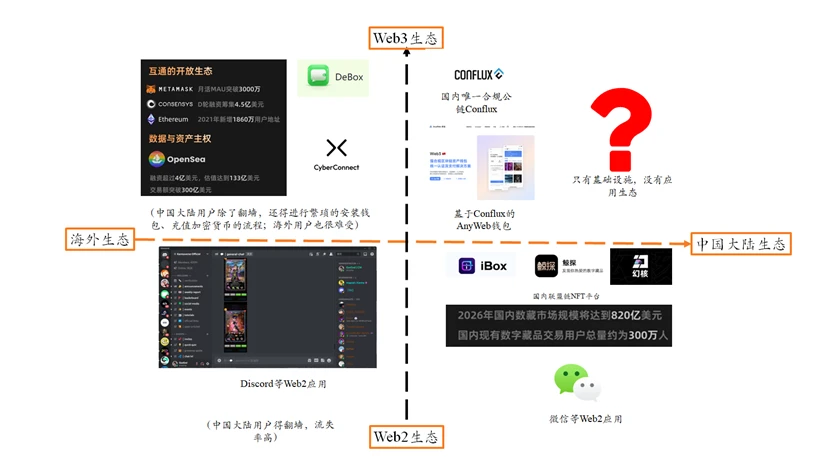
Market Share of Key Competitors
1. The Web2 world has established a very complete and even monopolized social ecology, from instant chat channels (WeChat, Discord) to social media (Weibo, Twitter) to content production platforms (Xiaohongshu, Zhihu) etc. How to break through from here? We must pay attention to the overall narrative logic of Web3, that is, the ownership of user data and assets.
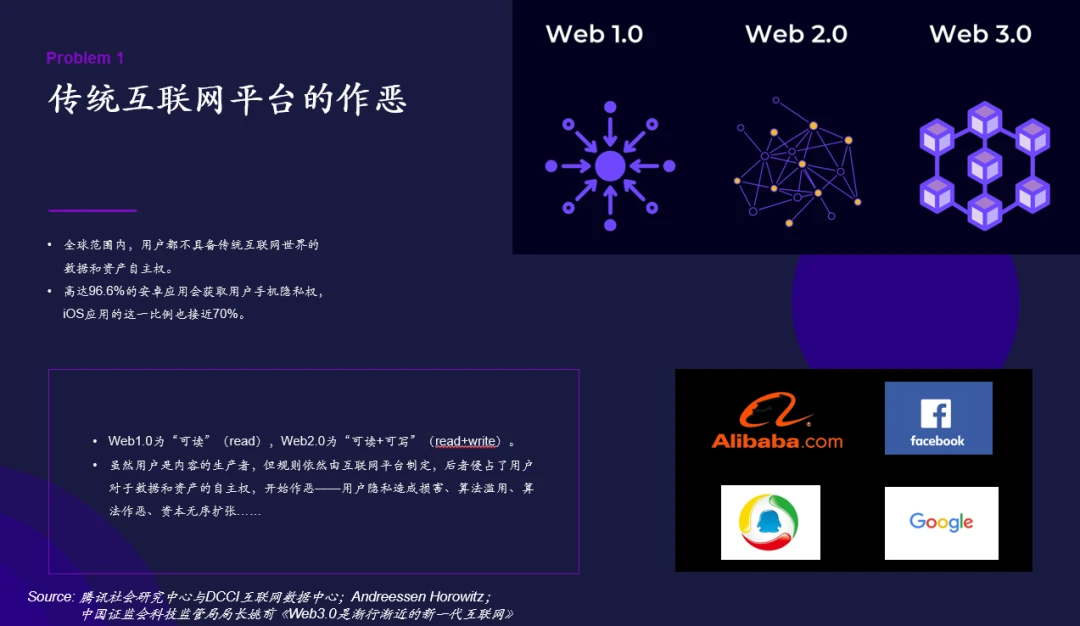
2. In the social scene of Web3, there are now two genres with different emphases
a. One is a DID pie, I hope to aggregate all the data around individuals, including behavioral data, achievement data, reputation data and contribution data, etc.
For example, have you provided liquidity in Uniswap, have you been liked by a big V on Twitter, have you contributed code and contracts on Github, etc. With the aggregated data, there can be usage scenarios. First of all, the airdrop of the project party generally obtains the users contribution certificate in the agreement. Or you can use a more direct indicator, such as a scoring mechanism like Sesame Credit. It represents Galex and Lens.
i. Galxe: Identify individuals through KYC services. (Among the existing solutions, one is to determine the ownership of the address on the chain by continuously verifying the behavior on the chain, such as nansens smart money tracking function; the other is to ensure the authenticity of the on-chain information through direct front-end KYC Therefore, it can be used as a source of identification for on-chain behavior.) KYC is not a decentralized operation method, and the actual principle of Galxe ID’s operation is not the decentralized method it claims, which is the most criticized part of its products.
ii. LensFrens, the official demonstration application launched by Lens, can basically be regarded as a decentralized Twitter, where users can follow users similar to themselves. Currently outstanding applications in the Lens ecosystem include decentralized social media application Lenster, LensFrens that can recommend profiles based on user Web3 footprints, Share-to-Earn social application Phaver, link trend ranking Refract, decentralized YouTube Lenstube, etc. , there are also relatively innovative projects such as Soclly, a time auction network for creators or veterans, Clipto, which provides customized services for celebrity videos, and LensAI, an NFT image generator created with AI technology. But the level of activity is very low: most applications have not yet achieved significant network effects. Currently, the number of Profile Mint is on the order of 100,000+, but its daily active users are around 600, and only 44% of registered users have published content. In Lenster, only about 10% of users have posted more than 20 posts, and 36% of users have posted at least one post. When the network is not active, there has been a trend of centralization of creators.

https://dune.com/iamyakuza/lensprotocol
ⅲ. Plug-in protocol represented by Mask Network: In essence, the user identification work of this model is completed by Twitter and Instagram, and user data is in the hands of users, which is a compromise to centralization.
ⅳ. ENS: First of all, ENS can not only be displayed as an NFT, but also an Ethereum network domain name that can actually run. By enabling IPFS services, a completely decentralized user experience process can be built, and individuals can fully control the domain name and data of the website. control without relying on centralized service providers. Secondly, the ENS domain name can also be displayed as a personal business card. After individuals and organizations purchase personal-related domain names, they can put them on social platforms such as Twitter to display their unique image. The total number of ENS domain name registrations has exceeded 2.55 million, and the number of users is 570,000. In September 2022, the number of ENS new domain name registrations will be nearly 400,000, surpassing the 378,800 in July, setting a record high in the number of monthly registrations. Behind the hot market of ENS is the resurgence of the traditional Internet domain name business. The hype logic is as follows: buy the domain names of top companies and organizations in reality, and wait for them to pay a high price; register Geely accounts, such as 666.eth, 888.eth Wait for numbers that meet specific audiences and wait for sale; buy in bulk, sweep goods at the logical low price of investing in PFP NFT, and sell them on the secondary market after waiting for the hot ENS domain name market.
ⅴ. Unipass: a low threshold wallet
iv. CyberConnect: CyberConnect only solves part of the DID, and recognizes the wallet address rather than the person. Three main functions are provided: Follow Button, Retrieve Followers and Follower List, and Get Suggested Follower List. On the home page, the wallet address used by the user to connect to the web APP will be displayed. In addition, users can connect to other existing social platform accounts based on the listed logos, including the centralized social platform Twitter, NFT trading market OpenSea, etc. Asset information such as NFT and POAP held by users will also be listed on the homepage. In January 2022, its number of users was around 400,000, but as of October, its number of users has exceeded 1.5 million. Binance, Protocol Labs and other 24 companies are deeply involved, and it also includes SpaceID, NFTGo, helloword, ZKlink and other 35 kinds of ecological applications.
ⅵ. POAP is a new way to keep a reliable record of on-chain experiences. Every time you participate in an event, POAP collectors will get a unique badge, which is supported by on-chain information. If social networking is a two-way point-to-point high-frequency model, then POAP is a proof of link between people and things, once participating, it is valid for life. In essence, this is similar to Lens Protocol. It is a component called by other POAP services. Any POAP project or project party can use POAP to build its own reputation system. When this system accumulates enough data, the personal chain The above information will be rich enough, and each active POAP can realize the function of DID.
ⅶ. HEYFOO: A wallet application for Web3 based on Conflux. Through the HEYFOO wallet, users can manage and interact with their four main attributes in the Web3 world: digital identity (digital membership with SBT characteristics), digital assets (data collection based on blockchain technology), Web3 experience (participation POAP obtained from the event), proof of contribution (points obtained by participating in the community, projects, and business co-construction)
ⅷ. quest 3: Users actively receive advertising information while completing tasks and receiving rewards, and then turn into community members, and carry out secondary dissemination for the project, achieving a win-win situation for both advertisers and users. Quest 3 wants everyone to earn cryptocurrency for completing quests and watching ads. Anyone can join the activity, and after completing the task, you can get a bound NFT as an achievement on the chain, and the data on this chain can be indexed by others after permission. But it can be seen that B-end users still send tasks on the homepage, and the activity is very low. C-end users have no own gameplay
b. The other school is the innovative scene school, which mainly attracts consumers to enter through 3D spaces such as the Metaverse, attracts new users with their novelty-seeking psychology, and then continuously records data with users’ activities in the 3D space, accumulates data, and then uses NFT Or token incentives for everyone.It represents Decentraland and Sandbox. However, how to increase the number of users and activity is a crucial issue. In the bull market, because KOLs and institutions continue to purchase land in these metaverse spaces, it has played a very good marketing effect and attracted retail investors to enter the market. However, everyone’s demand is mainly at the stage of C-end wealth effect and B-end marketing. As a result, in the bear market, with the ebb of the wealth effect, users willingness to participate has dropped significantly. Decentraland officially claimed to have 1,074 active users in September. However, according to DappRadar, it only had a maximum of about 500 active users in the past 30 days. This size can be said to be disappointing.
ii. Comparison of competitive advantages and disadvantages
1. The first is the comparison of Web3 social scene and Web2 social scene. Traditional Web2 such as WeChat group chat: 500 people group chat upper limit (not as good as discord), set up a lot of group chats, but the information is not interoperable; there is no NFT ticket access mechanism, users can freely join the channel without verification, so it cannot be realized In a low-cost trusted environment, many of the users in it are just people, and they dont really understand or like this project. Without a credible environment, most users are randomly pulled in. The proportion of users who really understand the project is very small, let alone users who hold the project. It can be understood as an external traffic pool, which belongs to saving face, but the real The value capture is too little, and the marketing effect is mediocre for the project side, most of which are dead groups (without a trusted verification mechanism established by the blockchain); the biggest problem is: there is no incentive for active speakers in the group chat, so it reduces Increased enthusiasm for speech and creation (without the creator economy brought by Web3)
2. The attempt of Web2.5: the main financial scene introduces users into the world of Web3. There are 500 digital collection trading platforms in China: only the attributes and scenarios of financial speculation are unsustainable. The popularity of the digital collection industry in 2022, I think, is completely irrational. The hype over digital collections is fundamentally based on the transfer of overseas desire for wealth expectations. When everyone finds that it has no practical use, cannot bring social vanity to show off value, and has no sustainable brand extension itself, the core of the collection will collapse, and the market will gradually return to rationality.
secondary title
Judgment of future competitive landscape
1. I think the overall social scene in the future must be: the stickiness of Web2 social products (network effects, novelty scenarios) + user data asset registration on the chain + user can have data asset utilization scenarios (transactions, advertising fees, etc.). Its just that the entry points of the two major genres have their own emphases. Judging from the current industrial development, since the relevant supporting facilities of Metaverse are still in the early stage, the effect of immersion has not yet reached the standard, especially reflected in the number of users, there will be a huge gap. So I tend to aggregate user data first, build production relationships, and then gradually improve the logic of productivity.
Project Analysis: Take two domestic projects as examples below
First of all, I need to introduce why I choose domestic web3 startups.
Combining the stock price and recruitment situation of the Internet at home and abroad in recent years, to be honest, I think the careers that young people can do in recent years seem to be two 3, which two three, one nucleic acid, and one Web3.
Now that the era of nucleic acids is over, what should we do after this? In the era of traditional Web2 Internet giants, it is difficult to have too many growth opportunities. It is difficult for young people of our generation to own their own means of production. In the overall economic downturn, it seems fate to be laid off at work and exploited in life .
But is it so?
The overseas Web3 revolution is in full swing, but the development of domestic Web3 is still in its infancy. There are some policy and market biases and constraints, but we should be able to see that the Chinese governments policy on blockchain technology is actually There are many. From the end of 2019, Xi Jinping determined that the blockchain is the core technology, so the future trend towards Web3 development is irreversible.
We believe that Web3 is the future, because it represents the users data sovereignty and asset sovereignty, and it is a declaration of war against the monopoly and exploitation of user data by traditional Web2 giants. This day will definitely come, and in the early days, evangelists like us are needed to promote and spread. Our mission is to influence more young people to enter the rabbit hole of Web3, so that everyone can understand, identify, and use the spirit of Web3 to solve many problems in the real world. To paraphrase a recent hot saying, in Web3, each of us can be the first person in charge of our own destiny.
And these, for Chinese users, especially young people, need to continue to preach and call. This is a spark.
Next, the specific case of choice: in the DID, I choose the circle badge; in the innovation scene, I choose a metaverse start-up company V (metaverse 3D space scene), we have conducted research and communication with the project party, and want to understand Their strategies, strengths and challenges.
2. Analysis of circle badge project
a. Project history and growth path
i. At present, users data assets are placed in the servers of centralized platforms. These Internet platforms use this part of data assets to sell advertisements and make profits, but users do not enjoy any benefits. So on this basis, creators have a hard time.
1. Part of it is PGC. These content creators are being exploited on a large scale by the platform, especially the creators of the long tail and the waist. They have not gained much economic benefits and cannot rely on themselves to receive business orders. For example, the up owner of station B can only honestly follow the platform’s sharing rules. If station B is having a hard time himself, the up owner can only take rewards from fans. How to solve the economic problems of these creators and protect their economic value exploited by China Literature, QQ Music, Netease Cloud Music, Bilibili, Kuaishou and Douyin? How to connect these creators with their consumers through the logic of Web3, this is the Web3 I want to see
2. The other part is ordinary UGC: the data assets in daily life are taken away by the platform. In the field of social networking and content creation, user-created videos, texts, analysis, second-created emoticons, high praise comments, etc. are all data assets, but the ownership is in the hands of the platform. Even if you post a comment on Douyin and get 100,000 likes, you won’t get anything, let alone money. In the future, everyone will not even know that you have such a glorious history.
ii. Lingdong can become a user-friendly Web3 universe in mainland China, where everyones data information and data assets can be in the hands of users themselves, and users themselves have the right to use and ownership.
1. The circle badge is the first product of Lingdong.
2. The initial entry point of the circle badge is the B-end attribute, and the positioning is a tool for the project party to organize activities. Taking THUBA as an example, THUBA can send a Tencent document at each event to let everyone sign in. This is a way of recording, but users cannot socially display it. But is there a better way? If you let everyone get badges on the circle, you will have a THUBA badge wall at the back, so you can see at a glance who has participated in which activities and who is an active contributor to the activities. So, gradually, for users, we actually make the circle the first digital identity that belongs to you, so that users can easily link and share your digital information (digital membership, digital identity) in the Web3 world. Activity records POAP, digital collections and digital credits, etc.). In the future, Circle DID.Ren will support users to issue their own digital information on the blockchain for free and migrate to their preferred blockchain.
3. The Circle Digital Badge is a blockchain-based digital memento used to record extraordinary moments in life. The circle digital badge will become the identity certificate of everyone in the smart universe, recording everyones life experience. Circle solves the current problem that users have no place to store and deposit their own data assets. Then, you can display your own badge (data credential), and the user can form an on-chain portrait. You can think of your SBT as a collection of 100 NFTs (regardless of whether these NFTs are transferable), and then all the data benefits will be shared by users; Users can use their own badges (NFT) to communicate and display data assets in specific channels; the embedded data asset trading platform matches Bole and Maxima. You can compare it to the domestic version of the poap+lens protocol, and based on this layer of user identity protocol, the application scenario of the creator economy is derived.
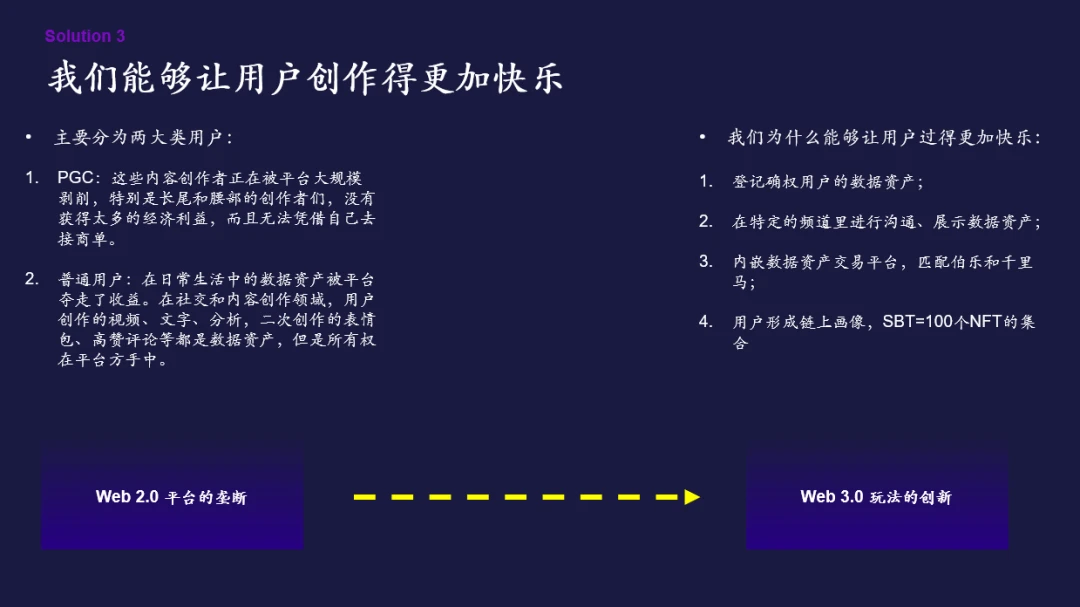
b. Project core competence
i. Leading edge:
1. Domestic competition landscape:
a. Everyone has not noticed that China can develop Web3, and it is generally believed that there is no Web3 ecology in China. Now the global Web3 is already quite rolled up, mainly because the number of users is too low, so they can only cut each other inward. In contrast, there are a lot of opportunities in China. We believe that the paradigm shift from overseas to China in the Internet and mobile Internet era will definitely come.
b. Everyone thinks that the current presentation method of Chinas Web3 is the alliance chain NFT, but the disadvantages are too great: 1. Users do not have private keys, so they have no real autonomy over assets, so once there is a problem with the platform, users have nothing. The representative example is Tencent Magic Core. After the announcement of the closure, the NFT inside became a worthless small picture, not even a bubble; 2. The underlying data is not interoperable, only a closed ecology; 3. Only the transaction function , Without a communication community and a display interface, users cannot develop real application scenarios. Therefore, it can only meet the speculative and hype needs of users. This is not to blame the users, because the project itself did not give users better choices, and this situation will definitely be revolutionized.
c. Everyone is looking for the real killer application of Web3. We believe that it is not enough to rely on isolated NFT trading platforms. First of all, social applications and aggregation trading platforms should be developed on domestic compliant public chains, which can bring more durable social scenes with capital value in addition to hype scenes, and can stimulate the creator economy.
2. Compared with other alliance chain companies based on pseudo-Web3 or the expensive gas fees on the public chain, the circle badge realizes a local optimal solution, which not only reduces the users on-chain cost, but also allows users to have a real ownership of assets.
to B side:
Compared with other competitors, the circle badge can allow B-end users to send POAP for free, reducing the cost of sending POAP. For example, Yuguan, each poap is 1 yuan, and it costs 1,000 yuan to send 1,000 poaps, which hinders the B-side.
Moreover, compared with external network applications that need to bypass the wall, the service of the circle badge can be used by all users in mainland China. For the B-side, the user base has expanded too much.
to C side:
Allow users to cross chains by themselves and migrate their badges and NFTs to their favorite chains. This is to allow users to truly own the ownership of assets and data.
Some people will say that it is not necessary to choose which chain, and users do not care; but I want to say that because users have no choice now, let alone know that they should have the right to choose, this is a process of good money driving out bad money, and only continuous evangelism And inspiration, let users know, let users have a choice, the attempt of Web3 in China must be like a spark.
In addition, for the C-end, a set of points system is designed in the circle. Points can be used to buy domain names, allowing users to play, domain names can be prostituted for nothing, or domain names can be purchased for a fee. Realize the wealth effect. The biggest difference between this and other small picture NFTs is that this domain name corresponds to your digital identity personal homepage, which has value in use, so it is not just speculation, but a solid and valuable support. This needs to be continuously iterated in subsequent products to reflect the economic model.
Therefore, the unique advantages of this product in the B-side and C-side of the circle are not only a web3 application for young people in the future, but also the optimal solution under the shackles of the current policy and market environment.
ii. Core competencies
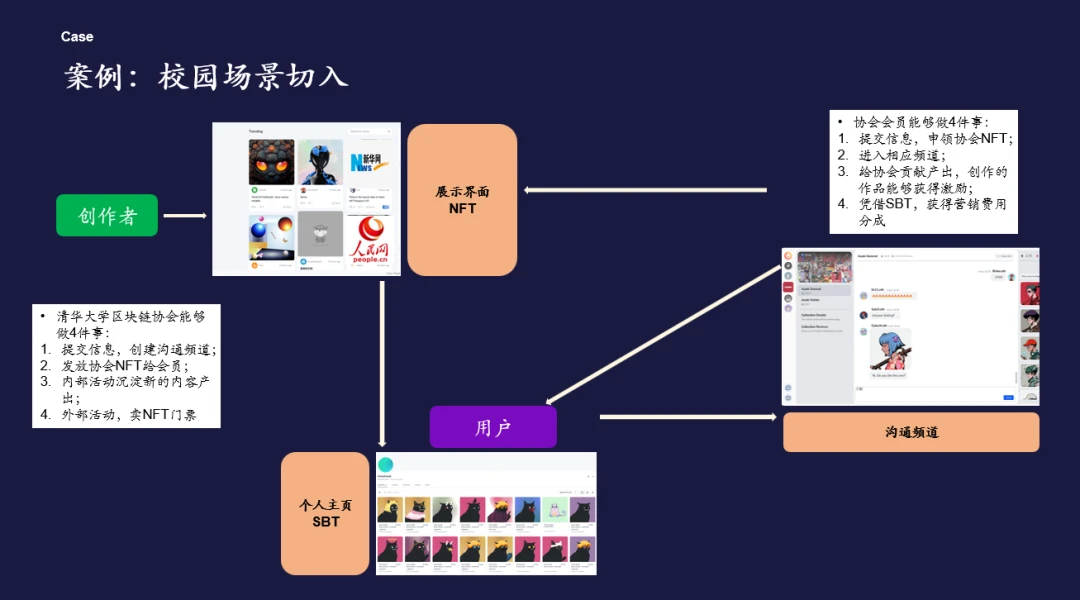
ⅲ. Moat: In the early stage, it is the subdivision of the scene, and then the growth of users forms a bilateral effect network effect. In the end, it must be the cognitive level of the management team, and we must always grasp the changes of the times
c. Current business analysis
i. The income structure is mainly: 1. Marketing fee commission; 2. Printing fee and courier fee (small money) for printing badges on the chain into physical certificates
d. Analysis of future performance growth points;
Analysis of core elements driving performance growth
i. It is mainly the growth point of users: seed users are young people. Chinese college students are willing to accept new things, are interested in new data labels, and have a lot of time. College students have a sense of identity and are very happy to accept a little economic stimulus. The 200 million young people in China are early users.
ii. Subsequent growth:
1. Use the interconnection of data and assets to make users sticky: Since users can communicate, socialize, and create economy in the corresponding channels on the Lingdong platform, you can directly see which projects are hotly discussed and hold positions With a large number of people, it is no longer a black box with black eyes that is cut into leeks by the project party, so stickiness will naturally arise.
2. After users have stickiness, they naturally want to complete one-stop operations on the platform, including purchasing and trading NFT. Then users will take the initiative to transfer the NFT they own directly to the Lingdong platform from other digital storage platforms.
e. The practice of decentralization
i. The circle badge will be connected to the alliance chain ecology (via BD) without the users private key, and the NFT assets of the overseas public chain, so that Chinese users can obtain all the assets and portraits of the entire web3 world with only one account.
ii. A sustainable and sound development of Web 3.0 must meet a major premise in the design of the economic model, that is, the project must give users non-monetary benefits, such as health, social interaction or entertainment, otherwise it is a project built under Ponzi The drum-passing scam. Therefore, you can’t just rely on the platform token as an incentive, because the token will be wiped out sooner or later (as long as there are no new users), and then there will be a death spiral. Through the introduction of user rewards, purchases, paid rentals, etc., to continuously increase external asset input and non-monetary income output

f. Analysis of management and operation capabilities
i. Analysis of the team situation: the core members are all from Tsinghua University and traditional Internet companies, with equal emphasis on technological innovation and idealism, senior practitioners in Metaverse and Web3, with experience in alliance chain development, wallet applications, NFT trading platforms and economic models, etc. Have a deep understanding of the industry.
3. A metaverse start-up company
V project analysis
a. Project history and growth path
The i.V project is a domestic NFT transaction and Metaverse scene platform, established in 2022. At the beginning, it started with a digital collection platform, and successively established the PGC platform (artists and IPs can issue NFT with permission) and the UGC platform (ordinary users can issue NFT by themselves). After capturing the huge beta of the Chinese market in 2022, it has accumulated millions of users, gained a firm foothold in the field of digital collections, and then began to build an independent metaverse space, so it can be commonly understood as the domestic version of Opensea+Decentraland .
b. Project core competence
i. At present, the number and activity of users in metaverse spaces around the world are relatively low. The idea of the V project is to first gather and retain users through the NFT trading platform, and then give users real application scenarios through the metaverse space. At present, the V project metaverse and its own central city AURO have been opened, and the independent app will be launched soon. It has been introduced to China Soong Ching Ling Foundation, China Environmental Protection Foundation, Huawei, China Resources Vientiane Life and many other institutions and well-known brands at home and abroad to build multiple scenarios. More powerful brands are under negotiation.
ii. Core competencies: At the technical level, the V project uses the worlds most advanced mobile engine + self-built V project editor to build a growing cosmic core to help creators create 3D content ecological scenes with complex interactions and economic interoperability; At the economic level, the V project has created a safe and open economic system, built a 3D content production and consumption platform, and empowered participants to forge and issue digital assets. So far, it has completed nearly 3 billion transactions; at the community level, the V project has a million High-level community users enjoy high-quality consumption content and entertainment process, and rank among the top in the domestic Metaverse space.
c. Current business analysis
In the early stage, the income mainly comes from the fee commission of NFT transactions. In the later stage, it will gradually expand to the commercialization in the metaverse space, including brand marketing revenue, metaverse land sales revenue, etc.
d. Analysis of future performance growth points;
Analysis of core elements driving performance growth
i. The main driving factor is still around the metaverse space. Whether it is web2 or web3 metaverse space, considerable resources have been invested in brand marketing, and there are many cases in this part that can be used for reference. The brand side can use the low-cost 3D content production tools provided by the V project to create a 3D virtual high-quality ecological space, integrating commercial sales, game setting, entertainment interaction, IP/commodity NFT casting, brand marketing and promotion diversification, live e-commerce promotion and other multi-functional advantages, using the mutual empowerment of real and virtual scenes, and powerful communication with consumers to realize online and offline consumption interaction. Millions of young users in the V project ecosystem will also start immersive experience, consumption, social networking and sharing here. At the same time, the development of more new products, user services, and rights exchange will continue to promote the brand to quickly occupy the minds of users and generate more value retention.
ii. In addition, gradually open the authorship of UGC. The production capacity of UGC has been fully released in the metaverse space, creating new ways to open up more opportunities for cooperation. The creators are good at video creation and live broadcasting through 3D scene blessing and targeted content transformation. Innovative thinking is not limited by space, with richer forms and outstanding effects. But correspondingly, the human cost of content review also needs to be invested. In the early stage, the solution of the V project is that all UGC does not generate basic elements (such as land, tiles, etc.), and needs to be built based on the elements that have been built on the platform, which is equivalent to every Everyone is a designer.
iii. In addition, actively cooperate in the layout of the entire metaverse industry chain, such as participating in the angel round financing of the new AR company Thin Red Line Technology founded by Lao Luo.
iv. In general, the overall idea of the V project is to solve the important problem of what do users do when they enter the metaverse space and what needs do they meet. In the future, we hope to build: Stronger IP influence: create our own IP light years and digital people; more influential joint names: such as joining more international luxury goods, fashion brands, and Chinese cultural super IPs such as the Forbidden City; more Rich and diverse interactive forms: live broadcast, games, concerts and more.
e. The practice of decentralization
i. Currently there is no economic model of ERC-20, mainly related to NFT (721, 1155).
ii. Based on the alliance chain without a private key, it essentially adopts a centralized governance method, so it is necessary to subsequently access DID for decentralized management of users and assets.
f. Analysis of management and operation capabilities
i. In terms of shareholders, currently they have access to state-owned capital, venture capital, etc., as well as policy support from Hongkou District of Shanghai, and try their best to cooperate with local governments and enterprises in metaverse brand marketing, industry promotion, and real economy empowerment.
4. Summary and evaluation
a. The current mainstream view of the market
i. What is the industry like? Is it worth paying attention to? Very worthy of attention.
1. SocialFi is known as the best channel for Web3 user growth, and it is the next way to introduce users after GameFi.
2. From the perspective of user experience, DID is the real starting point of Web 3.0, not the underlying network protocols such as oracles and public chains. DID marks the identity of the entrant; DID must be a function or module, not suitable for As a single product form, wallets, mailboxes, social media, log-ins, and validators can all be embedded with DID functions; DID as an identity identifier connects all Web 3.0 scenarios in series, DEX replaces CEX, ENS replaces domain names, etc., which will liberate personal data Ownership issues, personal values are transferable.
3. However, in China, there is still no interconnection between various alliance chains, and there are isolated islands of information. Therefore, it should be done synchronously: each “island” attracts users and retains them through different operational ideas. For example, the V project ends the NFT transaction to leverage users into the market, and then retains users through the Metaverse scene. At the same time, the construction idea of DID should be to open up the bottom users among the isolated islands through BD cooperation, so as to build a huge traffic pool covering all isolated islands, forming a through highway
b. The authors point of view: the experience and insight of the project
i. What is the industry like? Is it worth paying attention to?
1. The current bottleneck of the industry still exists, which is the problem of low entry barriers for users, otherwise it is the mutual cut-off of existing Web3 users, which is difficult to form a climate.
2. What can the user DID do after the data is aggregated, what application scenarios are there, and what gameplay can be retained?
3. In addition, the question of the economic model, how to give users enough incentives to make users motivated to enter the market. If it is purely for users to earn tokens, then Ponzi will be formed, and the death spiral will come soon, so there must be positive external income methods.
ii. How about this project? Is it worth the investment?
1. The metaverse is not just about cool AR scenes and VR devices, and blockchain technology is not just about deploying small digital pictures on the chain that have already made people feel tired. What Web3 is really about is a persons identity, behavior and value.
2. Again, I think the overall social scene in the future must be: the stickiness of Web2 social products (network effects, novel scenes such as Metaverse) + registration of user data assets on the chain (data aggregation, DID) + users can have data assets Use scenarios (transactions, advertising fees, etc.). Its just that the entry points of the two major genres have their own emphases. Judging from the current industrial development, since the relevant supporting facilities of Metaverse are still in the early stage, the effect of immersion has not yet reached the standard, especially reflected in the number of users, there will be a huge gap. So I tend to aggregate user data first, build production relationships, and then gradually improve the logic of productivity.
3. The three issues just mentioned:
a. Low entry threshold for users: register with your mobile phone number in the early stage, and when withdrawing cash later, because you have already obtained incentives, you are willing to bear the cost of registering the wallet, and it is a low-threshold wallet itself, which is relatively simple.
b. In terms of application scenarios, the current usage rate of DID derivative scenarios is seriously insufficient, and the activity is low. The main reason is that there is no way to spread through the self-fission of users, but only rely on the B-side project side to invest money in incentives for marketing. In fact, economic incentives are not completely eliminated, but the wool should not only come from the project party (issue currency overseas, or burn money to buy traffic), but mainly focus on B-end merchants (involving the calculation of new cost), And the incentives of C-end users themselves (for example, users can issue POAP when they make appointments for offline board games, and then everyone who receives POAP can get a monetary subsidy from the initiator if they come). In addition, through secondary creation, a model of big trunk (primary creator) + small branch (secondary creator) can be formed. The shared traffic pool and the creation of UGC by ordinary users can also be encouraged, thus forming a complete Ecological closed loop.
c. In terms of economic model, the fiat currency + NFT model can avoid compliance risks and at the same time reduce the platform’s token selling pressure, so in the end, most of them run through the model through external incentives and income.
5. References Reference
Decentralized Society: Finding Web3s Soul by E. Glen Weyl, Puja Ohlhaver, Vitalik Buterin :: SSRN
https://papers.ssrn.com/sol3/papers.cfm? abstract_id= 4105763
Decentralized Identity: Your Reputation Travels With You | Future
https://future.com/decentralized-identity-on-chain-reputation/
A Guide to DeSci, the Latest Web3 Movement | Future
https://future.com/what-is-decentralized-science-aka-desci/
bfrenz conversation Mask: Exploring the past, present and future of Web3 social
https://mp.weixin.qq.com/s/p-ZfryZhyxi0idMF2C3 MMA
Social Topic: From Walled Gardens to Civic Squares — An Overview of Social Protocols by Mask_ Bonfire Union (CN)
https://docs.qq.com/pdf/DUlNoQ 0 h 0 cURRUU 5 P?
Foresight Ventures: Breaking the Walled Garden, Web 3.0 Reshaping the Social Paradigm
https://finance.sina.com.cn/blockchain/roll/2022-06-17/doc-imizmscu 7321400.shtml
AT Family: Why did we invest in Hooked Protocol? - Foresight News
https://foresightnews.pro/article/detail/13981
Conversation with the co-founder of Galxe: Why did we change our name? How is it achieved from 0 to 1? _MarsBit
https://news.marsbit.co/20220913202109683225.html
AT View: The most detailed review of DID track on the whole network + three questions about DID soul
https://mp.weixin.qq.com/s/JwIITX 3 LAIQ1VvrRbEA 2 RA
In-depth analysis of SocialFi—from the current market to see the future development of SocialFi
Galxe: Create Impactful Experiences with Web3 Credentials
https://galxe.com/
Explain Lens Protocol in detail: How to reconstruct Web3 social relationship in the form of NFT? -Foresight News
https://foresightnews.pro/article/detail/6505
Social graph protocol CyberConnect, tearing down the Berlin Wall of platforms, individuals and communities — SeeDAO
https://mirror.xyz/seedao.eth/rzaAXEfvye_MBOVZEiVb2YFYXPS8D8KrH7HBSyFX7Ec
End-to-end connection: a decentralized link built by DID and on-chain data
https://mp.weixin.qq.com/s/YuEdqtd 4 WF 7 dI 7 t 510 xxlQ
Above the public chain, below the application: Talking about Lens Protocols Winter Wheat Planting Art - PANews
https://www.panewslab.com/zh/articledetails/4 bn 1 ecjm.html
What is the best marketing method in the Web3 era? -Foresight News
https://foresightnews.pro/article/detail/9527

